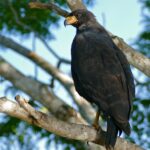The Great Black Hawk, a majestic bird of prey, weighs between 1.1 to 1.3 kilograms (2 lb 7 oz to 2 lb 12 oz). This resident breeding bird is found in the tropical regions of the New World, from Mexico through Central America to Peru, Tobago, and northern Argentina. As a coastal bird, it thrives in forest and open woodland habitats near water.
The Feeding Habits of the Great Black Hawk
The Great Black Hawk is an opportunistic predator, feeding mainly on reptiles, small vertebrates, and large insects. It employs a variety of hunting techniques to capture its prey:
- Perching and Pouncing: The hawk may spend a considerable amount of time perched, waiting patiently for the right moment to drop down and seize its unsuspecting target.
- Aerial Hunting: The hawk also searches for prey while soaring high above the forest canopy, scanning the area for potential meals.
- Ground Hunting: This adaptable bird will also hunt on foot, walking through the undergrowth in search of prey.
- Scavenging: Along the Amazon River, the Great Black Hawk has been observed raiding the nests of hoatzins, preying on their eggs and chicks.
Migratory Patterns of the Great Black Hawk
 Image source: Great Black Hawk by Bernard DUPONT
Image source: Great Black Hawk by Bernard DUPONT
While the Great Black Hawk is primarily a resident breeding bird, researchers have noted that it does engage in some altitudinal migrations when not in the breeding season. These movements likely help the hawk adapt to changing environmental conditions and resource availability.
Physical Characteristics of the Great Black Hawk
The Great Black Hawk is a large, predominantly black bird of prey with several distinctive features:
- Plumage: The adult bird is mostly black, with a yellow cere (the area around the beak) and legs, as well as dark eyes.
- Tail: The tail is black and white, providing a striking contrast.
- Juveniles: Juvenile Great Black Hawks are more brown overall, with brownish markings on their breasts.
- Proportions: This species has relatively long legs and a distinctive appearance.
Nesting and Breeding Behavior
The Great Black Hawk builds a platform nest made of sticks, constructing it high up in an emergent tree or on power poles. The female lays a single egg, which is white with red to purplish brown markings. The incubation period lasts between 35-37 days.
After the nestling hatches, it grows quickly, with the male working hard to bring enough food to the nest for the female and their offspring. The male will deliver the food close to or at the nest tree, and the female will retrieve it and feed the nestling. When the nestling is around 40 days old, it will be ready to take its first flight from the nest. Even after fledging, the young hawk will remain with its parents for several months, learning essential hunting and survival skills.
Conclusion
The Great Black Hawk is a fascinating and adaptable bird of prey, with a unique set of physical characteristics, feeding habits, and breeding behaviors. Its weight, ranging from 1.1 to 1.3 kilograms, is just one aspect of this remarkable species that continues to captivate researchers and birdwatchers alike.


